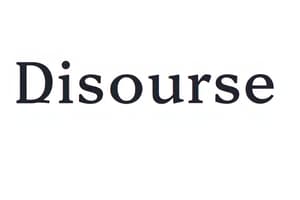Podcast
Questions and Answers
Which of the following is NOT a type of discourse?
Which of the following is NOT a type of discourse?
- Civil Discourse
- Written Discourse
- Visual Discourse (correct)
- Spoken Discourse
Which type of written discourse uses imagery and appeals to the senses?
Which type of written discourse uses imagery and appeals to the senses?
- Description (correct)
- Exposition
- Argumentation
- Narration
Which of the following is NOT a factor to consider for effective communication of a message in discourse?
Which of the following is NOT a factor to consider for effective communication of a message in discourse?
- Cohesion and flow
- Audience's age (correct)
- Tone
- Clarity
What is the primary purpose of argumentation in discourse?
What is the primary purpose of argumentation in discourse?
Which type of discourse uses logic and reasoning to convince the reader?
Which type of discourse uses logic and reasoning to convince the reader?
Which of the following brainstorming techniques involves writing down specific topics gathered from different sources?
Which of the following brainstorming techniques involves writing down specific topics gathered from different sources?
Which graphic organizer is best suited for visualizing the similarities and differences between two or more items?
Which graphic organizer is best suited for visualizing the similarities and differences between two or more items?
Which of the following is NOT a characteristic of a well-written text, according to the provided content?
Which of the following is NOT a characteristic of a well-written text, according to the provided content?
What is the primary purpose of revision and editing in the writing process?
What is the primary purpose of revision and editing in the writing process?
Which organizational pattern arranges information based on physical location or spatial relationships?
Which organizational pattern arranges information based on physical location or spatial relationships?
What is the key difference between a topic outline and a sentence outline?
What is the key difference between a topic outline and a sentence outline?
According to the content, what are the two main aspects of language use in a well-written text?
According to the content, what are the two main aspects of language use in a well-written text?
What does coherence in writing primarily refer to?
What does coherence in writing primarily refer to?
Which of the following best describes the purpose of cohesion in a text?
Which of the following best describes the purpose of cohesion in a text?
In the problem-solution structure, what comes after presenting a problem?
In the problem-solution structure, what comes after presenting a problem?
What should be avoided when using appropriate language in writing?
What should be avoided when using appropriate language in writing?
Which writing technique involves examining similarities and differences?
Which writing technique involves examining similarities and differences?
Which of the following is NOT a cohesive device?
Which of the following is NOT a cohesive device?
In writing, what is meant by 'unity' in a paragraph?
In writing, what is meant by 'unity' in a paragraph?
Why is formality an important consideration in language use?
Why is formality an important consideration in language use?
Which of the following phrases is considered a euphemism?
Which of the following phrases is considered a euphemism?
What is the primary purpose of definition in patterns of development?
What is the primary purpose of definition in patterns of development?
Which pattern of development uses rich descriptive words to create a mental image?
Which pattern of development uses rich descriptive words to create a mental image?
What is meant by 'chronology' in narration?
What is meant by 'chronology' in narration?
In comparison and contrast writing, what is the 'point by point' method?
In comparison and contrast writing, what is the 'point by point' method?
What does the problem-solution pattern typically include?
What does the problem-solution pattern typically include?
What characterizes the 'exemplification' pattern of development?
What characterizes the 'exemplification' pattern of development?
Which of the following patterns involves analyzing reasons and results?
Which of the following patterns involves analyzing reasons and results?
What is the main objective of the persuasion pattern in writing?
What is the main objective of the persuasion pattern in writing?
Which sensory approach is used in the description pattern of development?
Which sensory approach is used in the description pattern of development?
Flashcards
Discourse
Discourse
Communication that expresses ideas through writing or speech.
Types of Discourse
Types of Discourse
Different forms of discourse, including written, spoken, and civil discourse.
Written Discourse
Written Discourse
Pieces of writing such as essays, books, and blog posts.
Four Types of Written Discourse
Four Types of Written Discourse
Signup and view all the flashcards
Purpose of Discourse
Purpose of Discourse
Signup and view all the flashcards
Transitional Words
Transitional Words
Signup and view all the flashcards
Revision and Editing
Revision and Editing
Signup and view all the flashcards
Brainstorming
Brainstorming
Signup and view all the flashcards
Cubing
Cubing
Signup and view all the flashcards
Venn Diagram
Venn Diagram
Signup and view all the flashcards
Chronological Order
Chronological Order
Signup and view all the flashcards
Topic Outline
Topic Outline
Signup and view all the flashcards
Patterns of Development
Patterns of Development
Signup and view all the flashcards
Definition
Definition
Signup and view all the flashcards
Exemplification
Exemplification
Signup and view all the flashcards
Description
Description
Signup and view all the flashcards
Narration
Narration
Signup and view all the flashcards
Comparison and Contrast
Comparison and Contrast
Signup and view all the flashcards
Cause and Effect
Cause and Effect
Signup and view all the flashcards
Problem-Solution
Problem-Solution
Signup and view all the flashcards
Persuasion
Persuasion
Signup and view all the flashcards
Compare and Contrast
Compare and Contrast
Signup and view all the flashcards
General to Specific
General to Specific
Signup and view all the flashcards
Coherence
Coherence
Signup and view all the flashcards
Cohesion
Cohesion
Signup and view all the flashcards
Cohesive Devices
Cohesive Devices
Signup and view all the flashcards
Language Use
Language Use
Signup and view all the flashcards
Avoiding Jargon
Avoiding Jargon
Signup and view all the flashcards
Study Notes
Reading and Writing - Third Quarter, Lesson 1
- Linguistic is the scientific study of language, analyzing form, meaning, and context.
- Language is a complex structure of interconnected smaller units.
- Text is any information presented in written, spoken, or visual form.
- Discourse is communication expressing ideas, information, or meaning through writing or speaking.
- Types of Discourse:
- Written Discourse: essays, blog posts, books.
- Spoken Discourse: presentations, vlogs, oral reports.
- Civil Discourse: communication between two or more participants on equal ground.
- Four Types of Written Discourse:
- Description: Appeals to senses, using imagery to visualize scenes and objects.
- Narration: Storytelling; biographies, histories, and news reports.
- Exposition: Aims to inform; scientific and academic journals, essays, manuals, explanations of complex information.
- Argumentation: Presents a set of beliefs meant to be persuasive; relies heavily on logical arguments to convince readers.
- Purpose of Discourse: To inform, to persuade, to entertain.
- Factors to Ensure Effective Communication:
- Purpose: informing, persuading, entertaining, describing
- Audience: knowledge level, interests, beliefs, values
- Tone: formal, informal, authoritative, emotional
- Structure: clear introduction, body, conclusion; use headings, transitions
- Clarity: concise language, avoid unnecessary jargon
- Evidence and Support: relevant examples, data, references
- Cohesion and Flow: smooth transitions between ideas
- Style and Language: consistent writing style
- Revision and Editing: clarity, coherence, accuracy
Reading and Writing - Third Quarter, Lesson 2
- Brainstorming Strategies: Strategies used to gather information from various sources
- Cubing: Generate multiple ideas for a topic
- Free Writing: Writing continuously for a given time.
- Listing: creating a list of topic related ideas.
- Mapping: Visually organizing ideas through diagramming.
- Researching: using the big six questions to collect relevant information.
- Graphic Organizers: Visual tools for expressing ideas, knowledge, and concepts.
- Venn Diagram: Displays similarities and differences between ideas.
- Spider Map: Effective brainstorming and organizing tool.
- Fishbone Map: Cause-and-effect diagram
- Properties of a Well-Written Text: Selecting and organizing information, organization and structure, and language usage.
Reading and Writing - Third Quarter, Lesson 3
- Organization: The arrangement and structure of ideas, information, and arguments within writing.
- Organizational Patterns:
- Chronological Order: Ordering information according to time.
- Spatial Order: Arranging information based on physical location.
- Cause and Effect: Exploring the relationship between events and outcomes.
- Compare and Contrast: Examining similarities and differences between subjects.
- Problem-Solution: Identifying and addressing issues.
- General to Specific/Specific to General: Building from broad concepts to details, or vice versa.
- Coherence and Cohesion: The connection and organization of ideas in a text to create unity.
Reading and Writing - Third Quarter, Lesson 4
- Language Usage: Choosing appropriate language based on context and audience.
- Problems with Language: Avoiding issues such as informal language, jargon, slang, idioms, euphemisms, and biased language within written text to maintain coherence.
Reading and Writing - Third Quarter, Lesson 5
- Patterns of Development:
- Definition: Explains terms and concepts.
- Exemplification: Provides examples.
- Description: Creates vivid imagery of people, places, and things.
- Types: Sensory (using the five senses), Spatial (location based)
- Narration: Telling a story, chronological, or through sequences
- Comparison and Contrast: Shows similarities and differences.
- Cause and Effect: Explains the relationship between events.
- Problem-Solution: Identifying and addressing issues.
- Persuasion: Convincing an audience about an opinion or point.
- Comparison and Contrast: Methods for writing comparisons and contrasts.
- Point-by-Point: Switching between subjects
- Block: Discussion of one topic followed by a topic.
- Cause and Effect: The cause is the reason and the effect is the result.
- Problem-Solution Essay: Organizes ideas to solve a problem.
Reading and Writing - Third Quarter, Lesson 6
- Claims of Fact: Assertions that can be proven or disproven with factual evidence.
- Claims of Value: Judgments about what is good or bad, better or worse.
- Claims of Policy: Arguments for a course of action or a change in policy.
Reading and Writing - Third Quarter, Lesson 7
- Explicit Information: Clearly stated ideas within a text.
- Implicit Information: Ideas implied or suggested but not directly stated.
- Claims (Fact, Value, Policy): Types of claims with different aims and types of evidence.
Studying That Suits You
Use AI to generate personalized quizzes and flashcards to suit your learning preferences.




